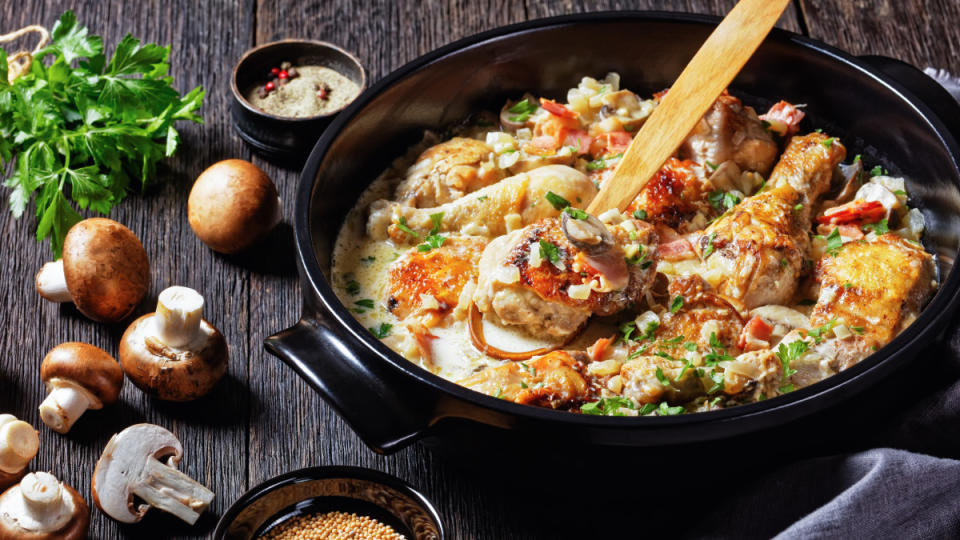All About James Hemings, One of America's First Celebrity Chefs

- Oops!Something went wrong.Please try again later.
- Oops!Something went wrong.Please try again later.
Baked Mac & Cheese
For centuries, French cuisine has been heralded as the highest form of culinary expression. Chefs all over the world have worked incessantly hard to perfect the technically complex haute-cuisine style of cookery, and its influence can be seen in the very dishes enjoyed en masse today. From mac and cheese to gumbo, there aren’t many dishes that don’t utilize some form of technique passed down from the meticulously organized brigade lines of Parisian kitchens past.
And while one can appreciate the influence of French technique in culinary endeavors today, it’s not often talked about how those techniques came to infuse themselves into the modern culinary landscape or the black and brown hands that helped popularize what is now known as American food.
James Hemings, in particular, happens to be a glaring omission from culinary history books. But thanks to historians and anthropologists alike, there is a wealth of new information about America’s first foodie influencer. So, who was Thomas Jefferson’s little-known chef de cuisine, and how did he help mesh French technique with American cuisine? Here’s everything you need to know.
Related: The Significance of Black History Month and Why It Is Celebrated in February
James Hemings was born enslaved in 1765.
James Hemings was born in 1765 in Virginia to an enslaved mixed-race woman named Elizabeth (Betty) Hemings, and his father, John Wayles, was their owner. James was one of 12 children, however, his father never acknowledged paternity of the five children he fathered with Elizabeth—including James. Before John Wayles passed, his daughter Martha married future President Thomas Jefferson, who subsequently inherited the enslaved population of the plantation known as The Forest.
James arrived at Thomas Jefferson’s Monticello at the age of nine.
Although little is known about James’ early childhood, historical records indicate that he arrived at Monticello at the age of nine with his family and siblings. As a teenager, he and his brother served as enslaved valets in Williamsburg and Richmond during Jefferson’s two terms as wartime governor of Virginia. They famously took his wife and children to safety when British troops invaded Richmond in 1781.
Hemings traveled to Paris with Thomas Jefferson in 1784 and trained as a cook.
Over the course of their relationship, James and Thomas Jefferson developed a rapport that allowed James to be afforded certain privileges uncommonly granted to enslaved people. In 1784, Thomas Jefferson—on his way to Europe to serve as minister to France—summoned James to travel with him. Once there, James learned the art of haute cuisine, and the rest is history.
Related: 24 Traditional Soul Food Side Dishes to Honor Black History Month

IMAGO / Pond5 Images
James was appointed Thomas Jefferson’s Chef de Cuisine in 1787.
After just three years of training under French caterer and restaurateur Monsieur Combeaux, James was appointed as head chef at the Hotel de Langeac. As head chef, Hemings was not only responsible for preparing intricate and over-the-top meals, but was in charge of a number of kitchen staff–including his white counterparts. He was also able to earn a salary, albeit half of what Jefferson’s previous chef de cuisine, a white man, received.
Hemings and Jefferson returned to Monticello in 1789, where James negotiated his freedom.
Upon their return to Monticello, amidst the beginnings of the French Revolution, James and Thomas struck a deal to grant Hemings his freedom under the stipulation that he would train his brother, Peter, in the art of French cookery. James wasted no time crafting dishes like coq au vin, creme brûlée, and cheesy, delicious macaroni and cheese. Due to his status as head chef to Jefferson, who was then Secretary of State, Hemings' dishes and recipes permeated through the country.
Related: 30 Black Americans To Celebrate During Black History Month and Beyond
James Hemings dies at 36 by apparent suicide.
After securing his freedom and pursuing personal endeavors in the culinary world, Hemings took his own life at the young age of 36 in Baltimore, Maryland. Although the only evidence is of oral lore, there are letters between Thomas Jefferson and his friend William Evans that allegedly confirm James’ cause of death. Despite being born enslaved and the shroud of mystery surrounding much of his life, James lived an incredibly fulfilled life and influenced culinary traditions far beyond his time. His legacy is best seen in the dishes of African-American chefs who have since reclaimed Hemings' story and honor him with their chosen brand of activism.
Up next: How to Celebrate Black History Month, According to Black Chefs

